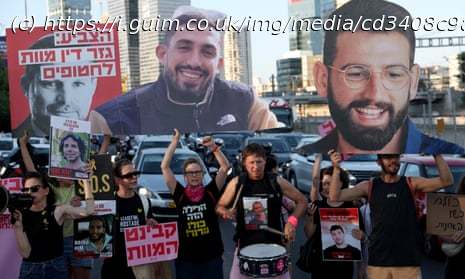Discovery of six bodies may trigger renewed protests as anger grows over prime minister’s handling of the crisis
Overnight, the rumours spread: the Israel Defense Forces (IDF) had found bodies in Gaza. Everyone in Israel knew the corpses were likely to be hostages seized on 7 October. The grim details – how many, their identities, and how and when they died – slowly emerged during the early hours of Sunday, to mounting sorrow and fury across the country.
The bodies of six people kidnapped alive by Hamas – Carmel Gat, Eden Yerushalmi, Hersh Goldberg-Polin, Alexander Lobanov, Almog Sarusi and Master Sgt Ori Danino – were found in a Rafah tunnel 20 metres underground, a kilometre away from where another hostage, Qaid Farhan Alkadi, was found in relatively decent health last week. Goldberg-Polin, an Israeli-American citizen, appeared in a Hamas video in April. It was clear from the footage that his left hand had been amputated.
Initial autopsies indicated that all six had died from shots to the head and had otherwise been in frail but stable condition, the Israeli daily Haaretz reported. The IDF said it believed the hostages were killed on Friday or Saturday, shortly before troops arrived at the location, to prevent their rescue.
It is too early to tell yet, but anger at their deaths could be the spark that reinvigorates the protest movement in Israel calling for a ceasefire and hostage release deal, as well as calls for new elections aimed at toppling the rightwing government of the prime minister, Benjamin Netanyahu.
Home
United States
USA — Science Hostage deaths could pile pressure on Netanyahu to agree Gaza ceasefire






